Recent Articles
Popular Makes
Body Types
2021 Hyundai Elantra HEV Road Test and Review
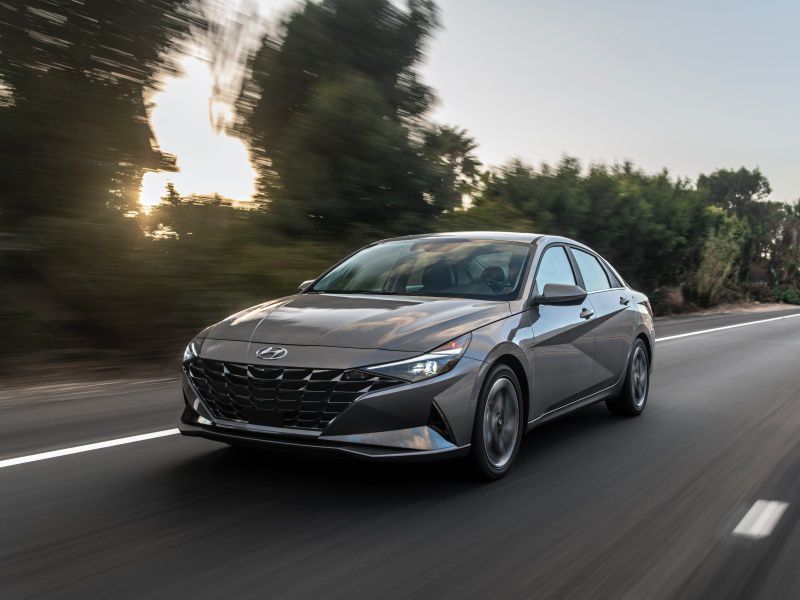
2021 Hyundai Elantra Hybrid ・ Photo by Hyundai
Hyundai is tripling down on its Elantra compact sedan even as Americans are moving away from small cars — and cars in general for that matter — and heading to crossover SUVs. But the all-new for-2021 Hyundai Elantra gives buyers three good reasons to buck the trend, one of them being the first-ever Hyundai Elantra HEV hybrid sedan. For mainstream buyers, the Korean brand has a new version of its conventional Elantra, and for those with a sporting bent, there is the performance-oriented N Line. Now as we seem to be entering a new era of higher fuel prices, the Elantra HEV (hybrid electric vehicle) strikes a positive note with fuel economy that tops 50 miles per gallon in a good-looking, easy-to-like sedan. With excellent interior room, a big trunk, and pleasant-enough driving characteristics, the Elantra HEV promises to provide strong competition to similar compact hybrid sedans like the Honda Insight and Toyota Corolla Hybrid.
Exterior
The 2021 Hyundai Elantra HEV’s exterior style exhibits a blank-computer-aided-design-screen approach in which its designers took some chances. They adopted the currently popular “four-door-coupe look,” making the seventh-generation Elantra Hyundai 2.2 inches longer overall and one inch wider. The wheelbase was stretched 0.8 inches, and the front overhang is shorter. The front cowl point was moved back a full two inches giving the car a much more purposeful look. The 2021 Elantra hybrid sports 16- or 17-inch wheel designs, and it offers a fully independent multilink rear suspension that is more sophisticated than the rear suspension in the non-hybrid car. That change, like most made for the hybrid, is largely invisible from the outside of the car. Subtle badges are the only clue that this is not your garden-variety Elantra.
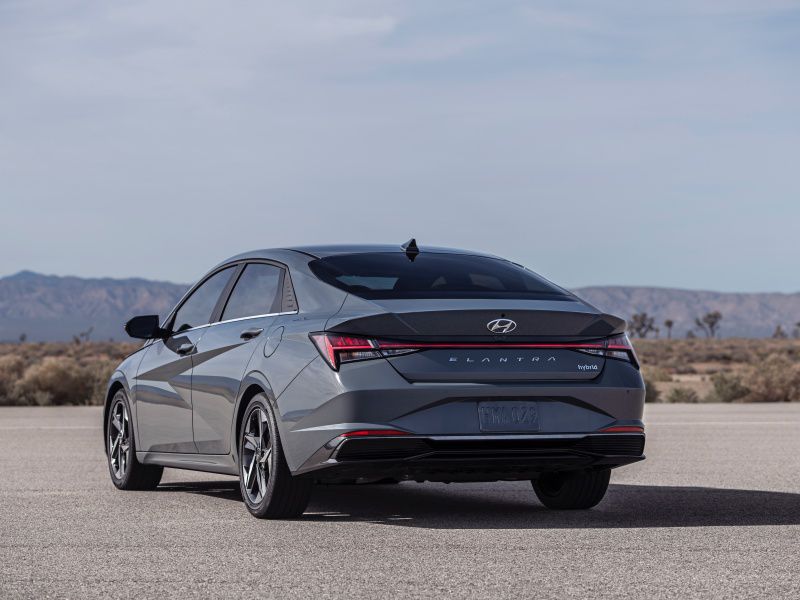
Photo by Hyundai
Interior
Many compact sedans offer incredibly bland, generic interiors, and we give Hyundai credit for breathing some life into the Elantra’s cabin. There are more hard plastic pieces than in new compact sedans like the Nissan Sentra, which has taken an upscale look as its key to success, but the Elantra’s interior is still attractive. Of course, the upscale model with twin 10.25 display screens, is dressed up with those screens alone. The Elantra HEV comes in Blue and Limited trim levels, and much of the differentiation centers around information delivery systems. The Blue has an 8-inch color display with wireless Apple CarPlay, wireless Android Auto, and HD Radio. Equipped with fabric-covered seats, the Blue has Bluetooth and steering wheel audio controls, selectable drive modes, and a rearview camera with dynamic guidelines. With the Limited, buyers get two 10.25-inch display screens — one for infotainment and the other for instrumentation and driver information — and seating is leather-covered.
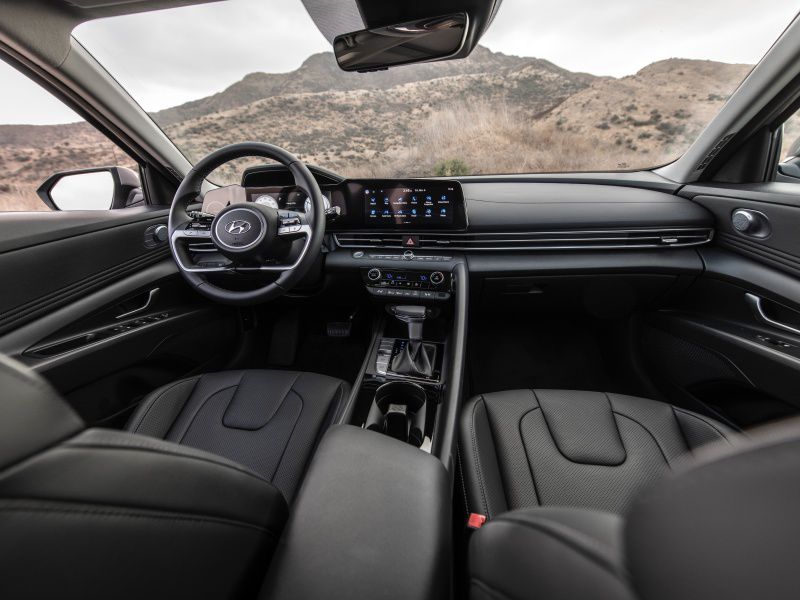
Photo by Hyundai
Infotainment
The 2021 Hyundai Elantra Hybrid’s infotainment system is clear and easy to operate, something we have come to appreciate from the Hyundai brand. As we just mentioned, the base display is an 8-inch touchscreen. One highlight is the car’s “natural language” voice recognition system that hones what is often a dissatisfying feature in other cars. Powered by Houndify, the system has been given the ability to use context, such as the vehicle’s location, to help it grasp what is being requested. A wide variety of climate-control functions can be manipulated by the system. The infotainment system in the uplevel Limited has a 10.25-inch screen and dedicated navigation, but we guess that many Elantra hybrid buyers would trade navigation for wireless Apple CarPlay and Android Auto that is not offered. The Limited does have Qi wireless charging and a Bose sound system with eight speakers, including wide-range speakers in the front doors and a woofer on the rear deck.
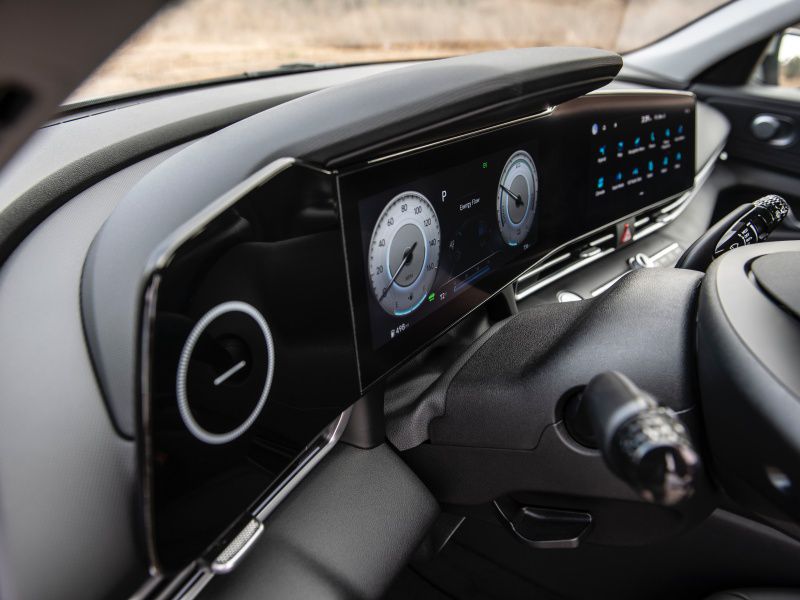
Photo by Hyundai
Hybrid Powertrain
The first-ever Elantra hybrid features a 1.6-liter GDI Atkinson-cycle 4-cylinder engine plus a permanent-magnet electric motor. The lithium-ion-polymer battery has 1.32 kWh of capacity, and it is positioned under the rear seats. Total system output is 139 horsepower and up to 195 lb-ft of torque. In contrast to gasoline-electric hybrid systems that use various types of continuously variable transmissions, the Elantra Hybrid’s gasoline engine is paired with Hyundai’s 6-speed, dual-clutch transmission. The presence of the geared, dual-clutch transmission gives the hybrid a driving verve that its competitors lack. Electric-motor torque is employed at various times to aid both fuel economy and drivability. The hybrid also has an electric-only mode, but the range in that mode is extremely limited.
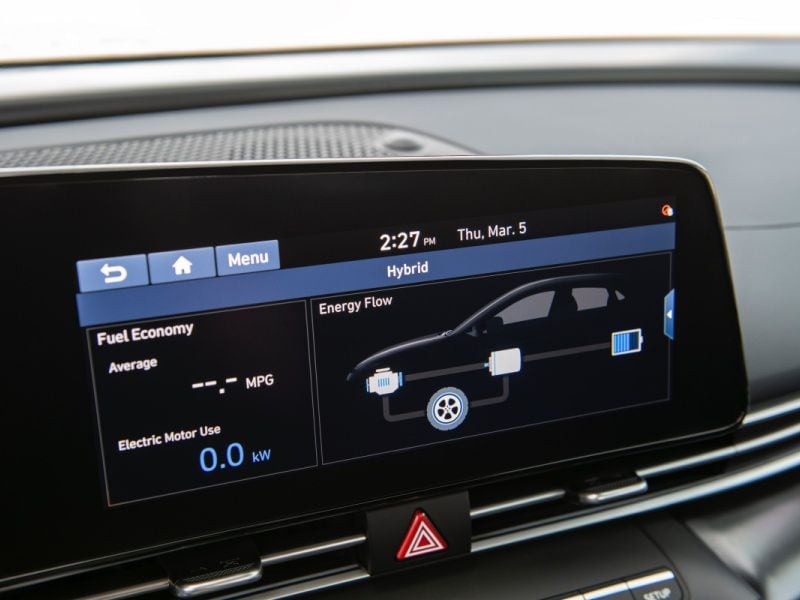
Photo by Hyundai
Driving Impression
While the Elantra HEV has the benefit of electric motor torque when advantageous and the dual-clutch transmission, don’t think of it as a sports sedan. Acceleration is leisurely and while the multi-link rear suspension aids handling, the car is set up for comfort, not performance. If you want sport buy the N Line or N versions of the car. Steering feel is appropriate for a mild-mannered hybrid, and the regenerative brakes that supply electricity to the battery pack don’t suffer from the “grabbiness” of some re-gen braking systems. What you get in the 2021 Hyundai Elantra HEV is a very fuel-efficient car that is still comfortable, quiet, and featured-filled. It’s not a canyon-runner, but its buyers will not be disappointed by its road manners. With more horsepower but less peak torque, the conventional Elantra offers overall performance that is very similar to the Elantra Hybrid.
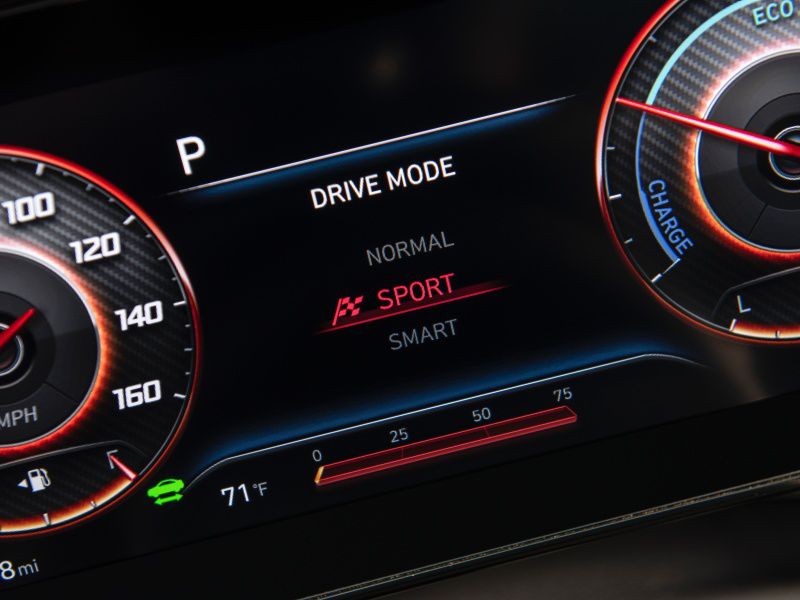
Photo by Hyundai
Safety/Driver Aids
The 2021 Hyundai Elantra HEV offers a very lengthy list of standard and optional safety and security features in its SmartSense package. Standards include Forward Collision-Avoidance Assist with Pedestrian Detection, Lane Keeping Assist, Lane Following Assist, High Beam Assist, and Driver Attention Warning. Blind-Spot Collision-Avoidance Assist, Rear Cross-Traffic Collision-Avoidance Assist, Safe Exit Warning, and a rearview camera system with dynamic guidelines are other standard safety features. Optional SmartSense features are Smart Cruise Control, Highway Driving Assist lane-centering and following-distance monitor, and Parking Collision-Avoidance Assist – Reverse. The last of these helps detect pedestrians and obstacles with a rearview camera and ultrasonic sensors, and it can provide warnings and apply emergency braking to assist in the avoidance of a collision.
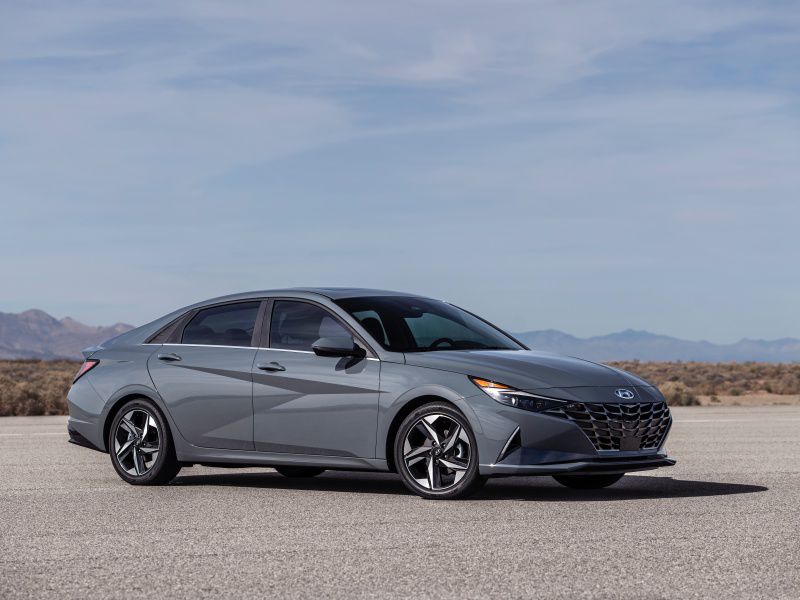
Photo by Hyundai
Interior & Cargo Space
The Hyundai Elantra HEV offers expressive style and a very pleasant driving experience, while at the same time delivering excellent interior space. Like its conventionally powered siblings, the Elantra hybrid is bigger than many of its key competitors. For example, it is more than an inch longer and an inch wider than the Honda Civic and Toyota Corolla. Among its typical competitive set, only the Volkswagen Jetta is longer. This results in added interior space including more front and rear legroom than most compact sedans. The Elantra offers 99.0 cubic feet of passenger space, while the Toyota Corolla offers 89.0 cubic feet and the new Nissan Sentra offers 96.0 cubic feet. The Elantra’s maximum cargo area is 14.2 cubic feet, about on par with others in the compact sedan segment. Inside the car feels more spacious than the competitive models, especially in the rear seats.
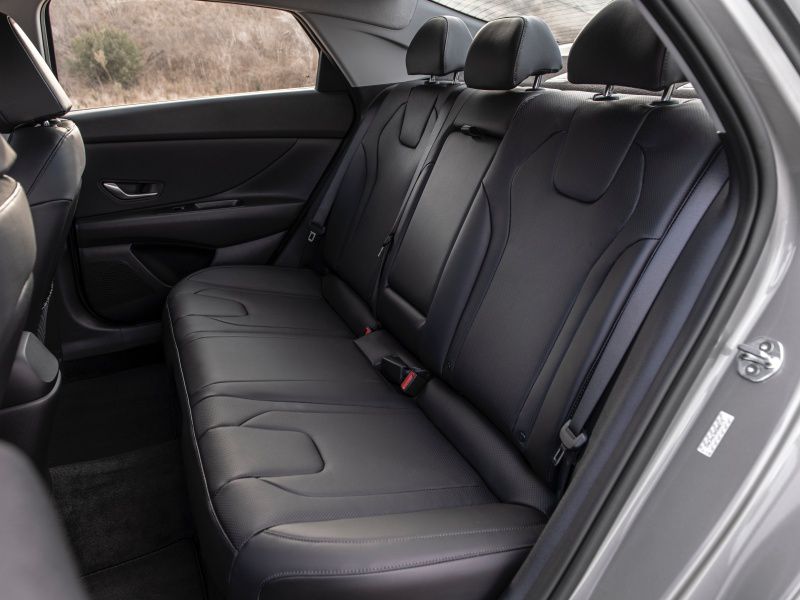
Photo by Hyundai
Fuel Economy
One of the reasons Hyundai executives are so excited about the new Elantra HEV is the drivetrain’s combination of torque-on-demand and excellent fuel economy. Fuel economy for the Blue trim is 53 mpg city/56 mpg highway/54 mpg combined. The Limited trim with larger tires and added equipment is EPA-rated at 49 mpg city/52 mpg highway/50 mpg combined. The Honda Insight has EPA ratings of 55 mpg city/49 mpg highway/52 mpg combined and the Toyota Corolla Hybrid has EPA ratings of 53 mpg city/52 mpg highway/52 mpg combined. In comparison, the conventionally powered 2021 Hyundai Elantra has EPA fuel economy ratings of 33 mpg city/43 mpg highway/37 mpg combined. The 2021 Hyundai Elantra HEV certainly holds its head up against the hybrid competition. At the same time, its conventional version offers excellent fuel economy at a lower price.
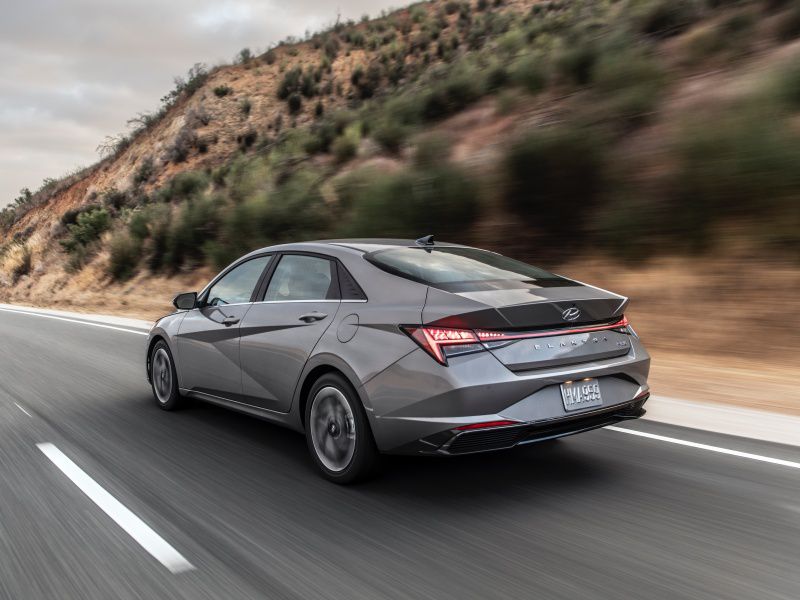
Photo by Hyundai
Trim Levels
The 2021 Hyundai Elantra HEV is offered in two trim levels: Blue and Limited. As mentioned, the Blue trim is the hyper fuel-economy champ, while the Limited ladles on additional creature comforts that knock down its fuel economy slightly. Still, that fuel economy is in the stellar range. The Blue trim includes an 8-inch touchscreen display, integrated voice command with Bluetooth, and AM/FM radio. Wireless Apple CarPlay and wireless Android Auto are standard, too. The Limited trim adds features like two massive 10.25-inch display screens, one for infotainment and the other for instrumentation and driver information. It has integrated navigation that the Blue level doesn’t. It doesn’t have wireless Apple CarPlay or wireless Android Auto, although it does have wireless phone charging. The Limited HEV also has ventilated front seats with memory-function adjustments. We think the Limited version will likely be the best value for most buyers.

Photo by Hyundai
Pricing & Value
The Hyundai Elantra HEV is a welcome addition to the increasingly crowded list of economical hybrid sedans. For its class, it is a reasonably fun-to-drive, 5-passenger compact sedan that has all the advantages of conventional sedans in the segment plus much better fuel economy. One of the most likable vehicles in the segment, the Elantra HEV is roomier than most in the class. The least expensive Elantra HEV has an MSRP of $23,550, plus $1,005 freight cost. An HEV Limited version has a suggested retail price of $28,100 plus the same freight charge. In contrast, the conventional Elantra Limited has a base price of $25,450 plus the freight charge. A 2021 Honda Insight LX, the base model, has an MSRP of $23,130, while the base 2021 Corolla Hybrid LE has an MSRP of $23,600.
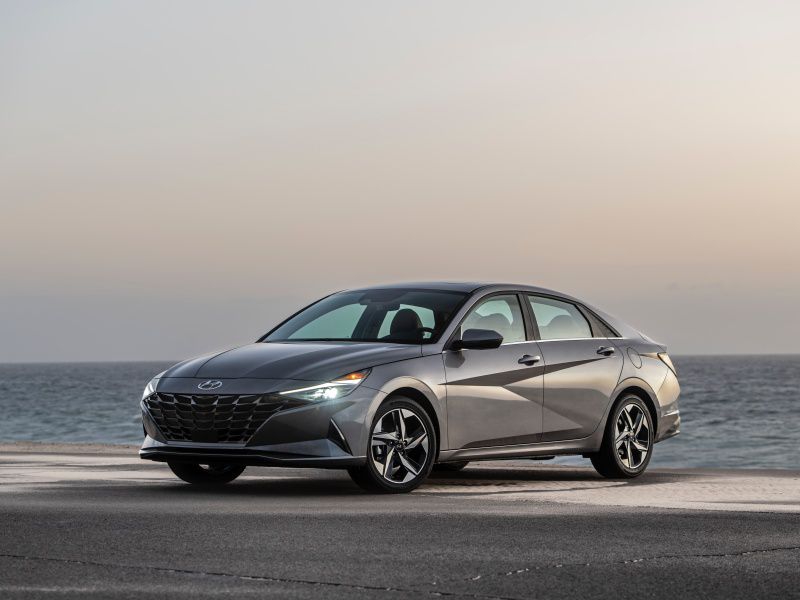
Photo by Hyundai